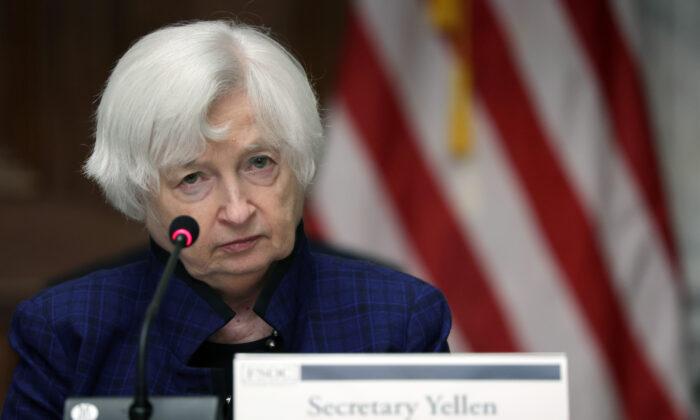The U.S. federal deficit surged 156 percent in the year through June as expenditures jumped while revenues continued to weaken, according to the Department of the Treasury.
The Treasury statement shows that June expenditures rose $96 billion, or 18 percent from a year ago, to $646 billion.
Income from taxes in June fell $42 billion, or 9 percent, to $418 billion.
Calendar adjustments were partly to blame for the big jump in the deficit in large measure because July 1 fell on a weekend. Without this, as well as other calendar adjustments, the June deficit would have been $142 billion, a more modest but still significant 66 percent increase over June 2022 levels.
Higher interest rates due to the Federal Reserve’s fight against inflation were partly to blame for the increase in expenditures. So far this fiscal year, which began in October 2022, interest on public debt has risen $131 billion, or 25 percent, to $652 billion.
Inflation-related cost-of-living adjustments have also added to Social Security outlays.
So far this fiscal year, outlays have risen by $455 billion, or 10 percent, compared to the same period last year, to $4.805 trillion.
Revenues have dwindled year-to-date by roughly the same amount. For the first nine months of the 2023 fiscal year, receipts fell $423 billion, or 11 percent from the year-ago period, to $3.413 trillion.
Part of the decline is due to sharply higher individual tax refunds as the Internal Revenue Service (IRS) cleared a backlog of unprocessed receipts.
US Federal Debt Projected to Soar
America’s public debt is projected to rise to concerning levels over the next three decades, a recent analysis from the non-partisan Congressional Budget Office (CBO) shows.Federal debt is expected to surpass its historical high in 2029, when it reaches 107 percent of gross domestic product (GDP), according to the CBO.
The analysis shows that federal debt is then expected to continue to risk, hitting 181 percent of GDP by 2053.
“Such high and rising debt would slow economic growth, push up interest payments to foreign holders of U.S. debt, and pose significant risks to the fiscal and economic outlook,” CBO said in a statement, adding that so big of a debt burden “could also cause lawmakers to feel more constrained in their policy choices.”
Red Flags
The CBO estimate indicates that federal spending as a percentage of GDP is expected to drop steadily, from 24.2 percent in 2023 to 23.1 percent in 2026.However, spending then starts to rise, reaching 29.1 percent of GDP in 2053. By comparison, the average outlays to GDP ratio between 1973 and 2022 was 21 percent.
One alarming finding in the report is that the inflation-driven high-interest-rate environment, along with persistently large primary deficits, are expected to cause debt-servicing interest costs relative to GDP to go up by nearly 300 percent over the next three decades.
Further, an aging population combined with growing health care costs boosts federal spending “significantly” on major health care programs and Social Security, the CBO said in the report.
Much like the spending projections, revenues are expected to fall from now until 2026, when some provisions from the Trump-era tax act are scheduled to expire.
The CBO report expects revenues to fall to 18.4 percent of GDP in 2023 and continue to decline until 17.8 percent in 2026. Revenues then gradually rise to 19.1 percent of GDP by 2053.
The CBO report warns that if the federal debt continues to rise in relation to GDP at the projected rate, there “would be an elevated risk of a fiscal crisis” in which investors lose confidence in the U.S. government’s ability to repay its debt and make interest payments. This, in turn, could cause interest rates to “increase abruptly, inflation to spiral upward, or other disruptions to occur,” CBO warned.
Other adverse effects would be possible too; like if expectations about the future rates of inflation push higher, the U.S. dollar’s role as the dominant international reserve currency could be undermined.
“Concerns about the government’s fiscal position could lead to a sudden and potentially spiraling increase in people’s expectations for inflation, a large drop in the value of the dollar, or a loss of confidence in the government’s ability or commitment to repay its debt in full, all of which would make a fiscal crisis more likely,” the report states.
There are other factors beside the amount of federal debt that feed into the risk of a fiscal crisis, and the CBO said it’s unable to identify a tipping point at which the debt-to-GDP ratio would be so high that it makes a crisis likely or imminent.
The CBO did, however, assess the near-term risk of a fiscal crisis as low.





